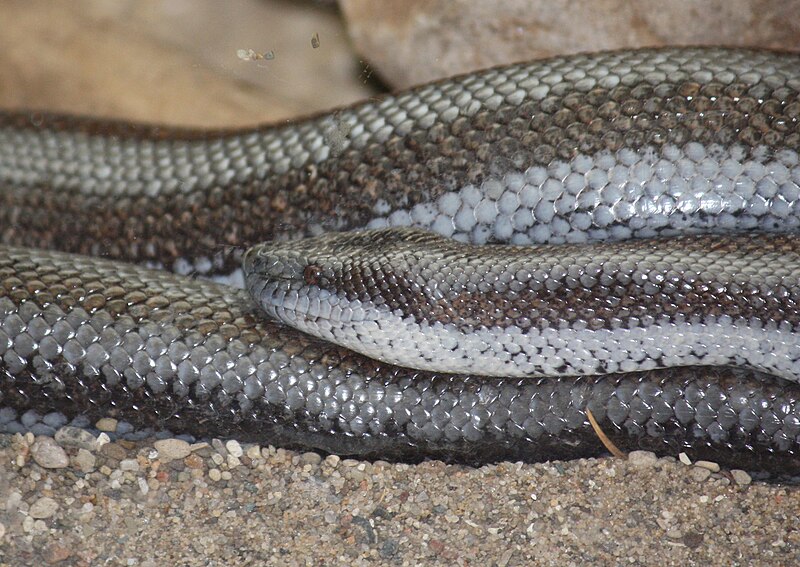I’ve come across several of the 11 unique snake species known as sand boas, and have had the good fortune of working with breeding groups of an Asian and African species. Following are some remarks drawn from my notes and conversations with colleagues.
Indian Sand Boa
The Indian sand boa (2 possible subspecies) ranges widely through India and Pakistan. Those I have kept have reproduced without a winter cooling period (this likely varies among the various populations). It is a good deal larger than the more popularly kept Kenyan sand boa, sometimes reaching 40 inches in length. Unfortunately, this impressive burrower is not commonly kept in the USA.
Courtship
Males in breeding condition go off feed and actively search for females. During courtship, the male attempts to unearth the female’s tail (she is generally below the sand when found) with his head. His spurs stand out slightly from the body and are rubbed along the female’s back. Copulation seems a quite awkward affair, with the male burrowing below the female and flipping more or less unto his back.
The Young
The young are born alive after a 4 month gestation period. They are larger than those of related species, averaging 10-11.5 inches in length. A bit of umbilical cord usually remains attached for a few days, after which time it dries up and falls off.
The young shed within 2 weeks of being born, after which most accept pink mice. In common with other members of the genus, young Indian sand boas likely prey heavily upon small lizards in the wild. “Scenting” pinkies with a lizard may encourage reluctant feeders.
East African Sand Boa (Kenyan and Egyptian)
The East African sand boa is frequently classified as two separate subspecies, the Egyptian and Kenyan, with the Kenyan being the more brightly colored race. However, taxonomists disagree on this point, with some considering the entire species’ name invalid (please see reference below).
Their reproductive mode parallels that of the Indian sand boa, but breeding is more likely if they are subjected to a winter cooling period (70F ambient, with a warmer basking site and a drop in temperature to 65F at night).
Mating usually takes place in June-August, and the young, 4-18 in number, are born in October-December. They are 5-8 inches in length at birth, and reach sexual maturity at approximately 2 years of age (at which time they are approximately 16 inches long).
Sand boa taxonomy is currently in flux; you can review the species currently accepted by the American Museum of Natural History at:
http://www.jcvi.org/reptiles/search.php?submit=Search&genus=Eryx
 The Rosy Boa (Lichanura trivirgata) and several of the Sand Boas (Eryx spp.) are among the most unique of the 53 species in the family Boidae. They are excellent choices for both beginning and advanced keepers, especially those with limited space. Stoutly-built but averaging only 24-30 inches in length, these “big snakes in a small package” are hardy, relatively easy to handle and breed, and adapt well to small enclosures.
The Rosy Boa (Lichanura trivirgata) and several of the Sand Boas (Eryx spp.) are among the most unique of the 53 species in the family Boidae. They are excellent choices for both beginning and advanced keepers, especially those with limited space. Stoutly-built but averaging only 24-30 inches in length, these “big snakes in a small package” are hardy, relatively easy to handle and breed, and adapt well to small enclosures. That Reptile Blog – Reptile, Amphibian and Exotic Pet Care and Information
That Reptile Blog – Reptile, Amphibian and Exotic Pet Care and Information
